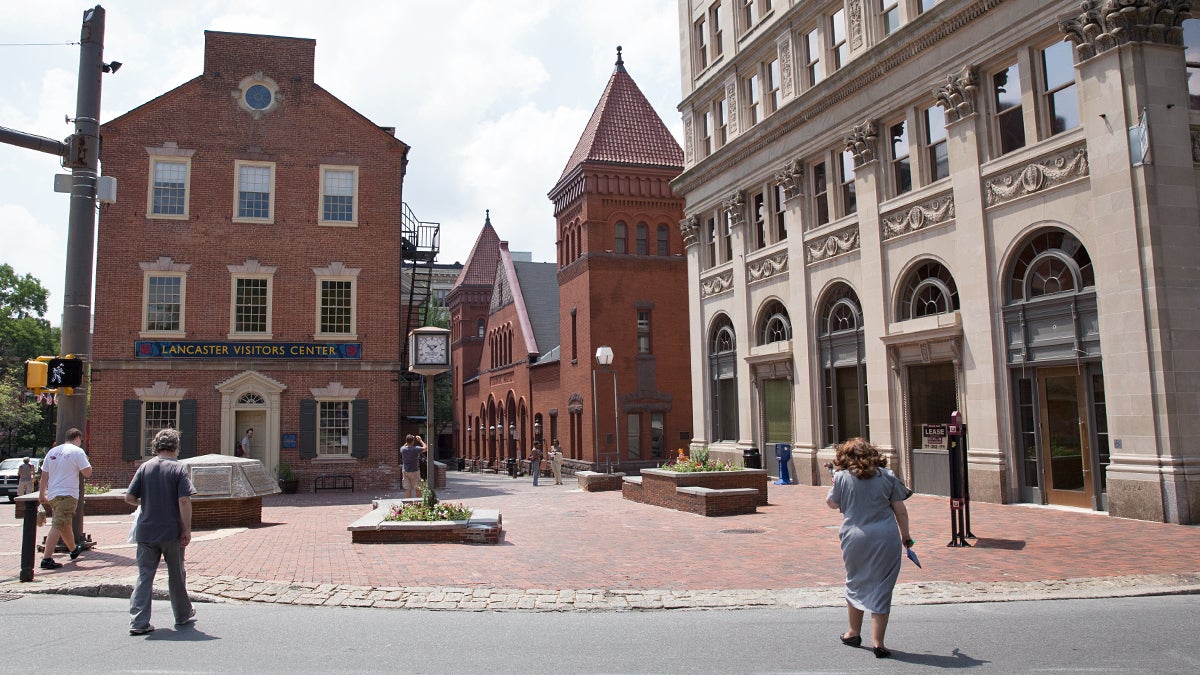Changes to state law boosts reinvestment funds available to communities

Pedestrians walk toward the downtown visitors center and Central Market in Lancaster, Pennsylvania. (Lindsay Lazarski/WHYY)
The state now considers only a business producing more tax revenue when calculating how much money to return to Lancaster, Bethlehem and Tamaqua.
Drastically bigger benefits are being produced by Pennsylvania’s Community Revitalization & Improvement Zone program due to tweaks in its rules.
Municipalities with a CRIZ get back however much more state and local tax revenue is generated each year by businesses within the zone compared to the year it was established.
Lancaster’s return was more than $3 million this year, more than 100 times as much at last year ($2,870). Bethlehem also saw a jump that, while less dramatic, was still more than double — $18,000 to $43,000 — according to numbers released Friday by the Pa. Department of Revenue.
Officials attribute the boost to the change in calculation method.
How it works
The CRIZ program was established in 2013, baseline tax revenues were established in 2014 and, in 2015, communities got their first returns from the program.
Initially, the state based rebates on collective changes in tax revenue produced by all businesses in the zone, combined, and didn’t include hotel taxes.
Both factors led to lower-than-expected revenues, particularly in Lancaster.
The city projected a $1.5 million return and got back less than $3,000, in part because officials thought hotel taxes would be counted in the mix.
Lancaster officials were joined by counterparts from Bethlehem and Tamaqua, each also home to a CRIZ, in lobbying state lawmakers to change the program so it would be more beneficial to host communities. The legislature quickly complied.
Adding hotel taxes to the mix helped, says Lancaster Community & Economic Development Director Randy Patterson, but he says the calculation change was more significant.
Instead of looking at the entire zone’s performance overall, the state now considers businesses individually and counts only growth in tax revenue. So if a business doesn’t generate as much tax revenue as in their baseline year, the state basically ignores it.
Using the former process, any declines in tax revenue would’ve counted against the amount of CRIZ revenue available because it was based on the entire zone’s combined tax performance.
Dramatic difference
Bethlehem’s CRIZ has just 38 properties. Two were new this year and their tax revenue is entirely responsible for the $43,000 recaptured by the city. The other 36, some of which are vacant, generated less taxes or the same amount, according to the Department of Revenue.
Nearly 700 businesses are included in Lancaster’s CRIZ . Of those, 41 businesses were new, meaning the entire amount of their eligible taxes could be recaptured, and revenue grew for roughly 400 of them. About 100 didn’t file CRIZ documents (and could face a fine for that) and another 100 or so reported flat or decreased tax revenue, according to the state’s report.
Tamaqua got its CRIZ one year after the other municipalities, so the borough’s $189,000 return is its first under the program. About $122,000 of that is from 105 businesses’ revenue growth and the rest is from eight new businesses. Taxes were flat or decreased from 55 businesses, and 26 didn’t report, according to the state’s release.
Tamaqua Councilman Micah Gorsky says the results also help show private investors CRIZ can provide a viable source of investment revenue.
The numbers also illuminate how the zone is performing.
WHYY is your source for fact-based, in-depth journalism and information. As a nonprofit organization, we rely on financial support from readers like you. Please give today.



